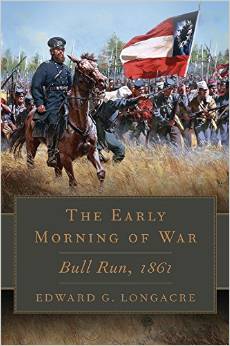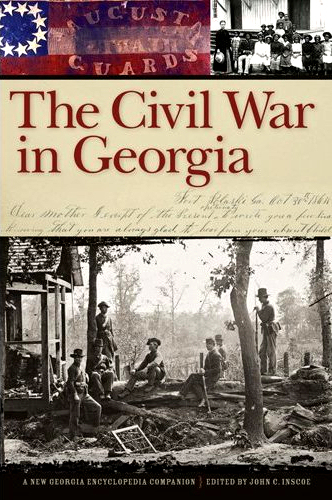The Early Morning of War: Bull Run, 1861 by Edward G. Longacre. University of Oklahoma Press, 2014. Cloth, ISBN: 978-0806144986. $29.95.
 Edward G. Longacre’s new history of First Bull Run is one of the University of Oklahoma Press’s most recent additions to its Campaigns and Commanders Series. The series’ stated aim is to issue studies combining the elements of military biography, operational analysis, and new military history. Longacre succeeds masterfully with the first two criteria. The first two chapters are biographies of Union Generals Irvin McDowell and Robert Patterson (commanding the Army of Northeastern Virginia and the Army of Pennsylvania, respectively), and of Confederate Generals Pierre Gustave Toutant Beauregard and Joseph E. Johnston (commanding the Army of the Potomac and the Army of the Shenandoah, respectively). These four biographies at the book’s outset are thorough and, alongside the numerous capsule portraits of brigade and regimental leaders, allow the reader to judge how the personalities and experiences of the opposing commanders shaped the unfolding battle.
Edward G. Longacre’s new history of First Bull Run is one of the University of Oklahoma Press’s most recent additions to its Campaigns and Commanders Series. The series’ stated aim is to issue studies combining the elements of military biography, operational analysis, and new military history. Longacre succeeds masterfully with the first two criteria. The first two chapters are biographies of Union Generals Irvin McDowell and Robert Patterson (commanding the Army of Northeastern Virginia and the Army of Pennsylvania, respectively), and of Confederate Generals Pierre Gustave Toutant Beauregard and Joseph E. Johnston (commanding the Army of the Potomac and the Army of the Shenandoah, respectively). These four biographies at the book’s outset are thorough and, alongside the numerous capsule portraits of brigade and regimental leaders, allow the reader to judge how the personalities and experiences of the opposing commanders shaped the unfolding battle.
Reading The Early Morning of War is a prodigious undertaking. The 502 pages of text are sourced with sixty pages of endnotes. Longacre’s tactical and operational narrative—the most thorough on First Bull Run available—is meticulous to the point that the serious reader will soon have flagged the book’s excellent maps, clear order of battle, and accessible index for easy, repeated access. Without regular recourse to these assets, readers unfamiliar with the battle can easily lose their way within Longacre’s reconstruction.
Nevertheless, the narrative moves briskly when Longacre is maneuvering the opposing armies into contact, marching regiments into the battle line, and bringing the experience of Civil War combat to life. He issues a convincing rebuke to the criticism that McDowell dawdled at Centreville, making it possible for Johnston to affect the battle’s outcome. The Union commander, in fact, had good reason to delay. He needed to draft a new tactical plan as well as requisition rations for his famished troops. Longacre also vividly describes the battle’s climax at Henry Hill. General Thomas J. Jackson’s Virginians on the right of the Confederate line held their positions long enough for a counterattack that Longacre credits to both Johnston and Beauregard’s timely interventions. At the moment McDowell celebrated with Colonel Michael Corcoran atop the heights, Confederate regiments were already on their way to reverse federal gains. Johnston has traditionally received the laurels for this effort, but Longacre demonstrates that Beauregard also sent numerous regiments into combat on Henry Hill. As a result, the Confederates’ “multipronged assault swept all before it” (422) and prompted the federal withdrawal of General Oliver O. Howard’s brigade from nearby Chinn Ridge. Regiments of Carolinians and Virginians continued forward from Henry Hill, reinforced by two additional brigades from Beauregard and Johnston. Together, these units administered the Confederates’ coup de grace to the Union right and precipitated a general retreat of McDowell’s forces. Longacre gives due attention to the successful Union holding action at Blackburn’s Ford to keep open the lines of retreat. The Union rout is colorfully described, but Longacre devotes most of his criticism to the Confederate forces’ “stunted pursuit” (448). The indecision of President Jefferson Davis and the onset of heavy rains on July 22 compounded tactical inertia. The Early Morning of War’s tactical analysis of First Bull Run makes the battle a harbinger of the indecisive violence that would characterize most Civil War combat.
Longacre’s sustained employment of the techniques pioneered by the “new military history,” unfortunately, is not as fully developed. For instance, he clearly relates the operational impact of the impending departure of the Union’s three-month volunteer regiments just prior to the battle. Two regiments in McDowell’s army with expired terms endured the calumny of comrades and the press for leaving the battlefield. Longacre makes good use of this topic as a means to explain that McDowell’s higher proportion of regulars and longer-term volunteers made his army a comparatively more cohesive force than Patterson’s. There is not, however, an analysis of why three-month terms were the norm for prewar volunteer service and why citizen-soldiers insisted on the honoring of these terms. Without such discussion, readers are left with the impression that contracts were simply shields for the cowardly or the homesick. In fact, the armies and populations of both sides approached with difficulty the eventual necessity of mobilizing long-term for a hard war.
Part of the explanation can be found in the traditions of local control and federalism that for at least two years restrained centralized direction of the war effort and consistent regulations across all forces. The patchwork army organized by half-measures that McDowell commanded in 1861 was a product of the habits of self-government and popular sovereignty ingrained in the society from which it emerged. Furthermore, these habits of soldiering and self-government are themselves part of the reason why only a defeat as shocking as Bull Run could have prompted President Abraham Lincoln to call for one million three-year volunteers within a week of the battle. Points of analysis such as these are not new, but their lack of development in Longacre’s treatment of the battle is nonetheless disappointing given the series’ promise of a multifaceted approach to campaign studies.
In sum, The Early Morning of War rewards readers with a detailed chronicle and analysis not only of the events at Manassas Junction, but of those in the Shenandoah Valley as well. Longacre delivers on his promises to “add greater tactical and strategic detail to its subject than any previous study” (xiv). At the same time, the quest for exacting detail and impressive coverage necessarily limited the author’s capacity to explore some facets of the campaign that a “war and society” perspective prioritizes. The book should also prompt historians to more consistently place responsibility for the Union defeat on the shoulders of not only McDowell, but of Patterson and General-in-Chief Winfield Scott. The Early Morning of War confirms First Bull Run’s historical significance and its existing place in the narrative of the Civil War.
Thaddeus M. Romansky earned his Ph.D. in History at Texas A&M University.



